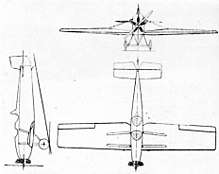Avia BH-12
| BH-12 | |
|---|---|
| Role | Sports plane |
| Manufacturer | Avia |
| Designer | Pavel Beneš and Miroslav Hajn |
| First flight | 1924 |
The Avia BH-12 was a two-seat sport aircraft built in Czechoslovakia in 1924, the final development of the Avia BH-9 family that had its roots in Avia's first aircraft design, the BH-1. It was a low-wing, braced monoplane intended for sports flying, and featured a redesigned wing that could be folded to allow the aircraft to be towed by road. The wing pivoted around its spar and then folded back, flat against the fuselage sides.
Specifications

Avia BH-12 3-view drawing from NACA-TM-37
General characteristics
- Crew: one pilot
- Capacity: one passenger
- Length: 6.34 m (20 ft 10 in)
- Wingspan: 9.77 m (32 ft 1 in)
- Wing area: 13.6 m2 (146 ft2)
- Empty weight: 320 kg (705 lb)
- Gross weight: 550 kg (1,213 lb)
- Powerplant: 1 × Walter NZ 60, 45 kW (60 hp)
Performance
- Maximum speed: 150 km/h (94 mph)
- Range: 520 km (324 miles)
- Service ceiling: 5,000 m (16,400 ft)
- Rate of climb: 3.3 m/s (660 ft/min)
See also
Related development
References
| Wikimedia Commons has media related to Avia aircraft. |
- Taylor, Michael J. H. (1989). Jane's Encyclopedia of Aviation. London: Studio Editions. p. 86.
- World Aircraft Information Files. London: Bright Star Publishing. pp. File 889 Sheet 86.
- Němeček, V. (1968). Československá letadla. Praha: Naše Vojsko.
This article is issued from
Wikipedia.
The text is licensed under Creative Commons - Attribution - Sharealike.
Additional terms may apply for the media files.